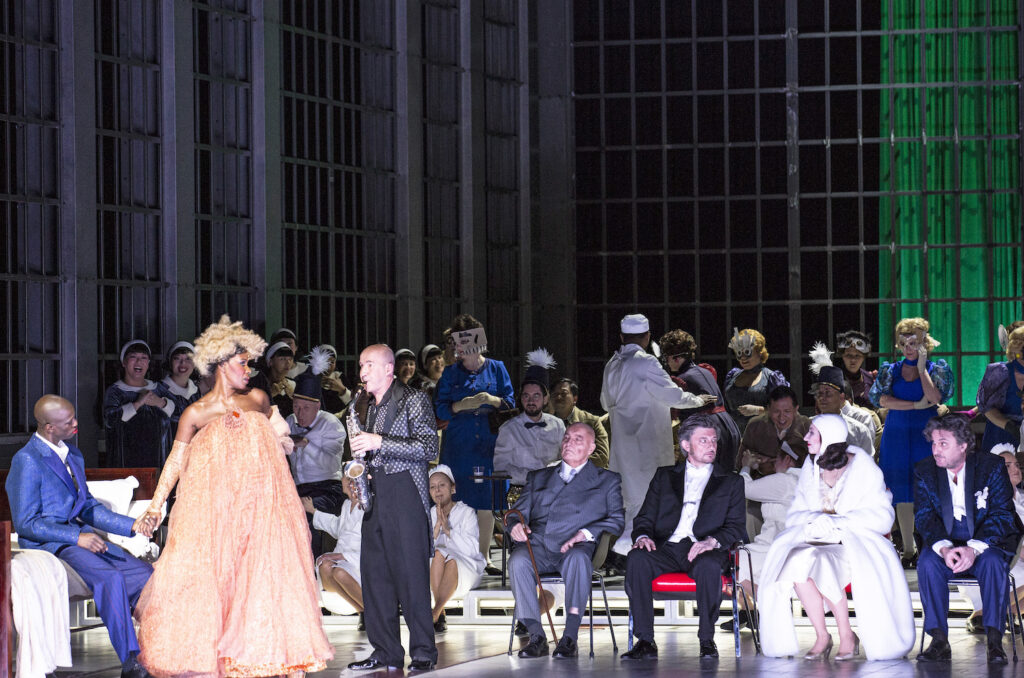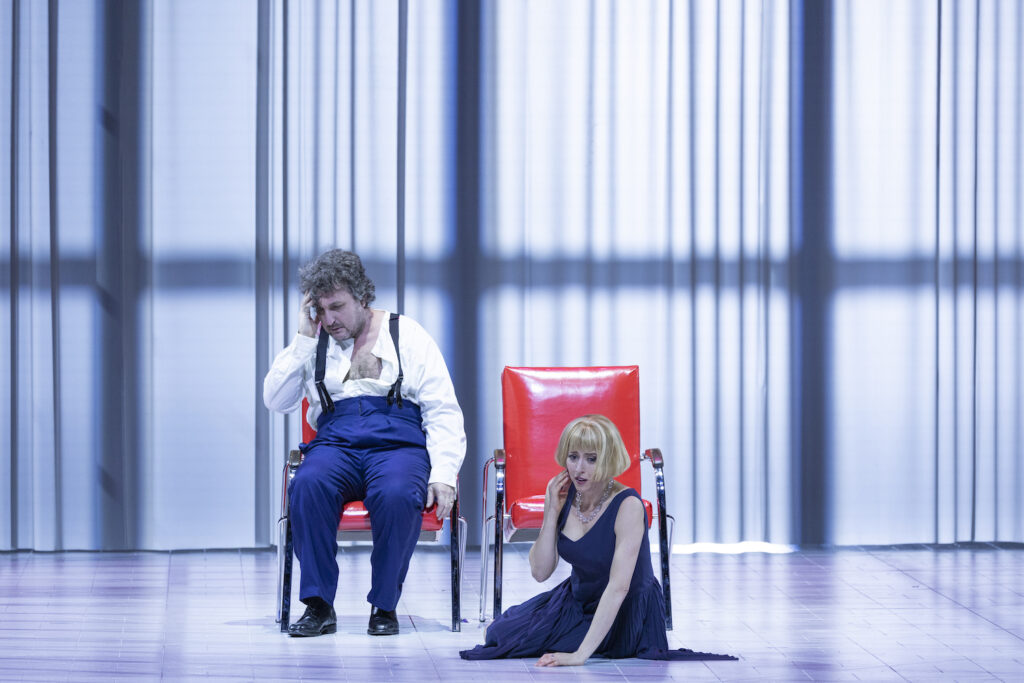Versions of Shakespeare’s famed Hamlet have amused Parisian audiences for 250 years or so, though just now at the Opéra Bastille we were as amused as we were confused. Polish stage director Krzysztof Warlikowski deconstructed Ambroise Thomas’ 1868 grand opera version.
Warlikowski had already placed a much purer, intensely lyric version of the play before French audiences at the Avignon festival in 2001. That was his production for Warsaw’s Nowy Teatr (in Polish) of the play, Hamlet’s haircut a cockscomb, Ophelia’s drowning delivered to a suspended, melting block of ice — unforgettable images.
The grand opera version just now was far more distilled, its actors voicing the words created by the esteemed librettists Jules Barbier and Michel Carré (the creators of Gounod’s Faust and Offenbach’s The Tales of Hoffman) that cast Alexander Dumas père’s French translation / version of the Shakespeare play into the emotive blocks that build an opera.
Warlikowski has again based his grand opera Hamlet on lines from Shakespeare’s Hamlet, telling us that when the cock crows all the night planets do not collide, witches do not charm, fairies do not dance., that night is a wholesome, hallowed time. It is intense dramatic irony that this blatant Warlikowski Oedipal tragedy unfolds within the purified light of such a night.
Grand opera is spectacle, Warlikowski and his wife/designer Malgorzata Szczęsniak use a huge projected black and white moon to overwhelm the old folks home / insane asylum — a huge cage — where the aged Hamlet’s very old, decrepit mother Gertrude sits in front of a black and white TV (see lead photo, copyright Bernd Uhlig), Ophelia and her brother Laërte sit, gleefully playing cards with a couple of other inmates.
When Act II begins we are told it is twenty years earlier, then only to be confronted by Hamlet as a troubled young boy many years before that, nervously zapping his red, toy car around the stage, refusing to call his uncle his father. The famed saxophone solo of the Ambrose Thomas’ play within the play is played on the stage, the murder enacted grotesquely by a band of minstrels — though real blacks, not blackface.

Photo copyright Bernd Uhlig
We know that Hamlet’s father was poisoned in his sleep, thus there is always a bed on the stage, where Hamlet attempts to kill his mother, where he attempts to kill Ophelia’s brother Laërte. We know that Ophelia drowned herself, thus there was a bathtub (a powerful French image) into which she immersed herself. We know that grand opera has a ballet to open its fourth act. A single, tutu-ed ballerina — a neurotic, sharp elbowed dying swan — added the sharp sounds of her frantic sous-sus-ing to Thomas’ lovely, delicate ballet, as the famed Shakespearean gravediggers added the sharp clicks of an antique typewriter to their macabre speeches over a corpse (it was not, we soon learned, Warlikowski’s Ophelia).
At the end of the opera, the last note sounded, we were left in silence, confronted again by this huge moon, only this moon in an extended visual fermata. No sound, no story, no song, only the timeless, empty light of the night.
The virtuoso performances of Hamlet by Ludovic Tézier, Ophélie by Lisette Oropesa and the Gertrude by Ève-Maud Hubeaux were the through-line, Aristotelian story tellers amongst the Warlikowski avalanche of images and manipulations of time and history.
Hamlet is a tour de force for baritone, an unrelenting torrent of words for the duration, his only respite Ophelia’s extended mad scene. French baritone Ludovic Tézier is 54 years old, at the height of his career. Though composer Thomas conceived his Hamlet for tenor, casting considerations at that original moment persuaded him to transform the role into baritone. Tézier’s voice is of a pure, bright color, and supple, giving him the youthful, sympathetic tonalities of a Marcello and Posa, with the power and stamina to sustain Hamlet’s ruminations, ravings and explosions. A consummate singing actor Tézier traversed the aged Hamlet, the child and the adolescent, the drunk — “Ô vin, dissipe la tristesse qui pése sur mon cœur!”, the philosopher — “Être ou ne pas être”, and the bitter, repentant lover — “Comme une pâle fleur”, with maximal tenorial aplomb.

Photo copyright Elisa Haberer
Ophelia’s complex mad scene is a welcome island of repose amidst the agonies of marital betrayal, fratricide, and Oedipal vengeance. Warlikowski’s Ophelia presents herself as a ghostly, flighty nocturnal creature, simply dressed with a very plain wig of blond hair describing the wasted life that she foretells in her splendid second act aria “Adieu, dit-il, ayez-foi!”. Thomas’ Ophélie was beautifully sung, and acted with uncanny poise by American soprano Lisette Oropesa. Mme. Oropesa’s upper voice shone magnificently throughout the evening, and of course particularly in the intricacies of the mad scene. For this famed episode her plain blond wig was changed into a splendid, platinum Cleopatra like wig, and among its myriad sections she danced a waltz with a sharply elegant, black clad danseur.
Hamlet’s mother Gertrude, French mezzo soprano Ève-Maud Hubeaux, cuts an imposing figure, her initial appearance as an aged, wheelchair bound crone morphed into the towering, colorful complexities of a an adultress, a widow, a queen and a mother, complete with a headdress that recalled a hen’s plume. Thomas’ Gertrude has one of the opera’s finer arias “Je croyais près de vous trouver mon fils” (Act II), though she mostly shares hugely tense scenes with both Ophelia and Hamlet in a richly focused voice that was both frightened and confident, then demanding and suppliant. Her husband, Hamlet’s uncle Claudius, sung by fine French bass Jean Teitgen revealed his guilt and remorse for his murder of Hamlet’s father in his one aria, “Je t’implore, ô mon frère!”. If forgiven he would be in a state of grace, I.e. saved from his damnation, thus Hamlet knows he must be killed in a drunken state, the final scene.
At the appropriate moments these dark machinations are recorded by a tall man knitting at the side of the stage, recalling as well the women who knitted tranquilly while watching the executions during the French Revolution. At the end the demented Hamlet appears, white faced, like the moon, as well the black players reappear, now in white face. Ophelia dressed in the white of her madness lies dead on the stage apron. And then there was only the moon.
No stranger to history’s great tragedies, Warlikowski staged a famed Elektra at the Salzburg Festival, where this summer he stages Verdi’s Macbeth.
The brilliance of the production and the excellence of the performances elevated the musical importance of the Thomas Hamlet score. Young French conductor Pierre Dumoussaud brought quite magnificent life to this difficult opera, where recitative, arioso and aria flow into one musical, rarely uninterrupted continuum. He gave a charged emphasis to the massive grand opera off-stage brass choirs and the massive on-stage choruses that composer Thomas imposed onto the pseudo profundities of the narrative.
The supporting roles were appropriately cast, notably the spectre of the dead king, darkly intoned by British bass Clive Baylee and Ophelia’s brother Laërte, brightly intoned by French tenor Julien Behr. Horatio and Marcellus were enacted by Frédéric Caton and Julien Henric, the gravediggers by Alejandro Baliñas Vieites and Maciej Kwasnikowski, and the brief Polonius (father of Ophelia’s and Laërte) intervention by Philippe Rouillon.
Krzysztof Warlikowski’s creative team includes Malgorzata Szczęsniak for the costumes and architecture, Felice Ross for the sophisticated lighting requirements, Claude Bardouil for choreography and movement, and Denis Guéguin for Warlikowski’s increasing use of video for huge visual effects.
Michael Milenski
Opéra Bastille, Paris, France, March 21, 2023. All photos courtesy of the Opéra national de Paris.